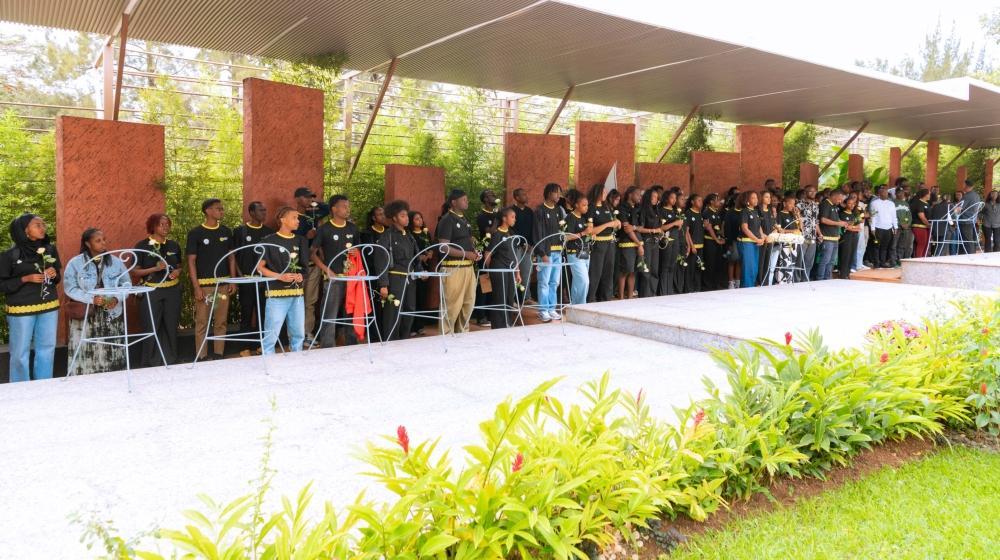Tom Ndahiro
Africa-Press – Rwanda. If ever there was a story to shake the very foundation of our shared humanity, it is the Genocide Against the Tutsi in Rwanda. It is more than a history lesson draped in African suffering but also a mirror that reflects what any society, under the right (or wrong) conditions, can become.
Rwanda’s truth is a fear-provoking story of what happens when institutions fail, when ideas are weaponized, and when empathy is overridden by fabricated identity.
If ever there was a moment for the entire world carriers and professions— historians, lawmakers, philosophers, psychologists, theologians, educators, media houses, activists, and ordinary citizens—to pay attention with both ears and open hearts, it is now. What the world, and I personally witnessed, is a matter of existential urgency. It is no longer a matter of continental proximity or cultural familiarity. Because the kind of hatred that erupted in Rwanda in 1994, has no nationality. It is a global threat.
I say this, not only as a scholar of genocide but as a survivor of its deepest, darkest form. A genocide not just against the body, but against bloodlines, against reason, against the sanctuary of a mother’s womb.
And, I speak of the Genocide Against the Tutsi, which unfolded in Rwanda in 1994, as the world looked away, happily mitigated by geopolitical apathy and racist presumptions. This is not a plea for pity—but a cry for comprehension, and a call for collective reckoning. A summons for the world to consider that what happened in Rwanda is not only part of African history—it is a mirror to the fragility of human conscience when infected by hate, propaganda, and fear.
This genocide is still unknown in its deepest wounds. It is my feeling that it has not been studied enough, mourned enough and understood enough. But feasibly more dangerously, it has not been feared enough.
The Genocide Against the Tutsi challenges not only our moral vocabulary but our capacity to imagine the breakdown of human boundaries in ways previously unrecorded. This was not a crime driven solely by ideology or hostilities—it was a genocide that weaponised intimacy itself.
This is a genocide that positions itself among the gloomiest moments of human history—not simply because of the scale or speed of the killings, but because of their sheer intimacy and grotesque internal logic. Unlike most genocides that involve one group turning its weapons on another, Rwanda witnessed a civil implosion engineered by colonial social science, religious dogma, and a deadly reimagining of national identity.
What occurred was not only a physical extermination of over a million people in a hundred days—it was a philosophical, psychological, sociological, and moral mutilation of humanity’s deepest bonds: kinship, motherhood, love, and shared belonging.
There were cases of auto-genocide in its truest form: a killing of one’s own, not merely in social or national terms, but genetically, spiritually. Rwanda under Hutu-power must be studied—not only as a humanitarian failure—but as a mirror held up to a civilization too confident in its moral evolution. This genocide tore through families not as collateral damage but as its primary goal.
What happened in Rwanda in 1994 cannot be compared in mechanical terms to other genocides, because the betrayal came not just from state institutions, but from family. The classroom was not merely a site of indoctrination—it became a space where children memorized hatred that would one day be used against their own cousins.
The genocide did not unfold solely through state orders or military strategies—it was born in soft voices, glances, church homilies, bedtime stories, and neighborhood gossip that evolved into declarations of death. This was the kind of genocide where victims were led to slaughter by people who were considered very good friends, that they knew the names of their cows and even pet dogs.
How does one process the fact that the final farewell to life, for tens of thousands of Tutsi children, came from the hands of people who once fed them porridge? That is why Rwanda’s story is not merely an African tragedy—it is the human soul’s most damning confession. And still, the world refuses to read it.
A question that reverberates in infinity
Sometime in 2024, a close relative sat with me, in the quiet shade of an afternoon filled with silence more eloquent and persuasive than speech. She asked me what I had learned in my years of studying the Genocide Against the Tutsi.
My answer was simple: “I have come to realize that what happened in Rwanda in 1994 is a special case of genocide, one the world must study more closely.”
She rested in and asked, “Uncle, why?” And my answer, I must admit, was foggy. How do you put into words what defies comprehension? How do you speak of the unspeakable—of mothers killing their own children, of brothers hunting their sisters, of fathers bludgeoning their own sons, because someone told them that the blood in their veins was the blood of the enemy? How do you even begin to analyze such a rupture of the most natural human instincts?
I tried to explain. I told her—of a Hutu woman who, along with her brothers and uncles, killed her Tutsi husband and all eight of her children. Her own children. Not enemies on a battlefield. Not strangers. Her children. She carried them in her womb, fed them, sang to them, perhaps once kissed their bruises and soothed their fears. And then she killed them. Or worse: watched them be killed and gave the killers her blessing.
The shock on my relative’s face was visible—like a clinical symptom of a trauma passed on secondhand. Her mouth opened slightly as if to speak, but words betrayed her. But it wasn’t over. Seven months later, I received a message from her. It was rare, emotional and unfiltered. The kind of message that reminds you that pain can travel across stories, and that disbelief is a symptom of sanity.
“I have buried my child—my firstborn. A congenital heart defect took her away from me far too soon. I remember walking away from the cemetery feeling like something inside me had died, maybe everything. The pain was unbearable; unlike anything I had ever felt.”
She continued: “That kind of loss never fully heals. And because I have lived through it, I cannot begin to understand how any mother would willingly choose to inflict such agony on herself.”
And then she returned to our old conversation. “Lately,” she wrote, “my mind has been consumed by the stories from the 1994 Genocide Against the Tutsi—particularly of the mothers who killed their own children simply because those children were considered Tutsi, even though they were actually half Tutsi and half Hutu, if that means anything to humans.”
Then came the most haunting question I have ever read: “When did such a terrifying conviction begin to grow in the mind of this woman supposed to be a mother?”
“Did those convictions develop in her heart when she married their Tutsi father or were they there before?” she asked. “From what I understand, such unions were often met with resistance. These were marriages forged through love, not convenience. Usually it was love that overcame so-called ethnic divisions. So how does a mother go from loving defiance to such horrific betrayal? Did she truly bear her children knowing she would one day kill them? That, I cannot believe. It’s hard for me to accept that a woman could nurture life only to destroy it, like one raising chickens or goats with slaughter in mind.”
But why stop with the mother? How does an uncle look into the eyes of his niece or nephew—the one who once called him ‘Papa wanjye’—and swing a nail-studded club into her skull? How does a grandfather give up his grandchildren to a mob of genocidaires, knowing they carry his blood and the laughter of generations? How can the same arms that once held those children high into the air to make them giggle, become the ones to throw them into pit latrines?
Certainly, this can’t be simplified into mere politics. This is pathology. Not individual mental illness, but a societal collapse of moral architecture. And that collapse was engineered.
The case that we face defies all explanations of the crime of genocide. With time I became convinced, the legal framework we inherited from the 1948 Genocide Convention—founded on the noble convictions of jurist Raphael Lemkin—is insufficient here.
Lemkin could not have imagined what happened in Rwanda 1994. That someone would kill their child to erase a bloodline they once loved. That hate would hijack not only politics or armies—but the most sacred of human bonds: motherhood.
What legal code has prepared us to understand that? The 1948 Genocide Convention mentions destruction of national, ethnic, racial or religious groups, but it remains silent on genocides within families. Rwanda added a new but unwritten clause to the moral jurisprudence of human cruelty.
There is no legal article, no line in the Rome Statute, that prepares the conscience to handle a mother who wipes out her own lineage for ideological purity. It is not enough to call this “incitement.” It is the erasure of nature by culture—a triumph of manufactured hate over maternal instinct.
The Genocide Against the Tutsi took the tools of propaganda, persuasion, theology, anthropology, and turned them all into tools of death. It was the culmination of everything gone wrong with modernity: the corruption of education, the betrayal of religion, the abuse of science, the manipulation of psychology, and the silence of diplomacy.
The death of conscience
To understand how this horror was made possible, and the framework of manipulation— we must go back to the architects of modern persuasion.
Edward Bernays, a nephew of Sigmund Freud, was the pioneer of mass manipulation. He famously said: “The conscious and intelligent manipulation of the organized habits and opinions of the masses is an important element in democratic society.” Bernays thought the public could be controlled like a herd, provided the right shepherds had the reins of media, psychology, and social norms.
In the hands of Hutu Power ideologues, Bernays’ principles became implements of extermination. Radio Télévision Libre des Mille Collines (RTLM), for example, operated like a hypnotic drumbeat, normalizing hate and turning ordinary citizens into killing machines.
School curricula had long prepared children to think of Tutsi as foreigners, cockroaches, and threats. Catholic Bishops like Andre Perraudin or Focas Nikwigize—gave blessings to killers. Artists like Michel Habarurema and Simon Bikindi composed songs glorifying death. All of society— priests, nuns, doctors, nurses, teachers, journalists, judges—contributed to the genocide.
It was the perfection of what French philosopher Jacques Ellul called “sociological propaganda”—the slow saturation of culture with an idea until it becomes common sense. In Rwanda, the idea was that killing Tutsis was not only acceptable, but indispensable, honorable, and even righteous.
Scholar Stanley Cohen, in his work “States of Denial,” outlines how entire societies rationalize and normalize atrocities. The denial isn’t just after the fact—it is built into the very execution of the crime. It is a preprogrammed silence, a defense mechanism of the group psyche. It explains how parents could murder and then host dinner in the same evening.
Robert Jay Lifton, who studied Nazi doctors, coined the term “doubling”—a psychic process whereby individuals split their identity to commit atrocities. A mother in Rwanda may have split herself: the loving caretaker and the Hutu Power disciple. But what or who enabled that split to override biology itself? The question remains unanswered.
Political scientist Philip Zimbardo’s research on the Stanford Prison Experiment revealed how situational forces and institutional authority could quickly dehumanize individuals. But Rwanda didn’t need a prison. It turned entire communities into moral vacuums. Zimbardo’s Lucifer Effect, which describes how good people turn evil, finds its full, terrifying case study in Rwanda—not in a lab, but in life.
And Ervin Goffman’s theory of dramaturgy helps us see how social roles were manipulated. A mother didn’t kill her child as a mother. She killed in the role of a “Hutu loyalist,” a protector or guardian of “Hutu purity.” Society handed her a mask and she wore it to the death of her own.
When the sanctified is despoiled
I say to theologians and moral philosophers: if Rwanda does not force a revision of your doctrines, then your doctrines are not rooted in reality. How does Christianity, with its emphasis on love, allow nuns to lock men, women and children in burning churches? How does Catholic theology digest the fact that the altar became the killing ground?
In Gaudium et Spes, the Catholic Church emphasized the dignity of the human person. But where was that dignity when bishops and priests sided with militias? Where was the outrage when the blood of Tutsis mixed with holy water?
There is a sin dreadful than commission: it is omission. It is the silence of those who knew better, who preached peace but exempted purgation. Their most sacrilegious iniquity was their silence and complicity, which is more perilous than the machete and a grenade.
We have to accept there is a global case study which has been ignored. The Holocaust became a foundation for countless human rights conventions, memorials, museums, films, and educational curricula. And rightly so.
But what of the Genocide Against the Tutsi? It remains neglected, often mislabeled, or confused. The media still uses euphemisms: “Rwandan Genocide.” That term is lethargic. It universalizes the crime and wipes out the victims. Say it clearly: it was the Genocide Against the Tutsi.
This genocide deserves study not only for what it reveals about evil but for what it reveals about how the world responds to Black suffering. While Holocaust denial is prosecuted in many countries, Tutsi genocide denial is often published, aired, and shared with impunity.
Authors like Charles Onana distort history with pseudo-scholarship. Like many genocidaires and other killers of truth and memory, Onana calls it a “war for power,” erasing the piles of Tutsi bodies and point the finger at their defenders for their deaths. Such authors are protected by academic freedoms but unburdened by academic honesty.
Meanwhile, genocidaires walk free, give interviews, publish memoirs, and are hailed as “opposition voices.” Songs written by genocidal musicians like Simon Bikindi are still online. Meaning? Hate against Tutsi survives on YouTube.
Humanity’s duty to respond
This is why I say to the world: Rwanda’s genocide is your case study. Not for Africans. For everyone.
To the United Nations: You failed in 1994. But will you now fund multidisciplinary research into the psychology of genocidal families? Will you document the untold heartbreaking stories?
To the African Union: Will you protect truth across Africa, or let revisionism become the new liberation ideology?
To psychologists: How do you process inherited trauma when your mother tried to kill you? How do you parent when your surviving aunt told you she killed your siblings?
To lawmakers: Will you update hate speech laws to reflect the Rwandan lessons on radio, songs, and public incitement?
To educators: Have you taught your students about this genocide, or does your syllabus end at World War II?
To moralists: When does a human heart rot to the point that blood ties become threats?
To journalists: Words matter. Names matter. Tell the truth. Stop glorifying genocide ideologues like Victoire Ingabire.
To citizens of the world: Wake up. The mechanics of Rwanda’s genocide are at play in your societies too: hate radio, ethnic nationalism, scapegoating minorities, rewriting history.
This is not a Rwandan tragedy. It is a human one. It is what happens when fear is stoked, when myths are sharpened into weapons, when propaganda becomes gospel.
Ask yourself: what would make you turn on your child? What would make your neighbor become your killer? If your answer is “nothing,” you haven’t studied Rwanda.
And if your answer is silence, then the next genocide has already begun. This is not just about memory. It’s about warning. It’s about truth and about justice.
Let Rwanda’s pain be your warning. Please study Rwanda. Weep for her. But more importantly: learn from her.
Because the unimaginable did happen. Rwanda defeated genocidaires and brought the country to sanity. It is a lesson from Rwanda. And, unless we study it, deeply and without euphemism, it will or can happen again.
Because if not now, then when? And if not you, then who? This is our task. Yes, it is. It is uphill and painful. But it is human.
A word for a napping world
To every think tank, university, pulpit, parliament, and boardroom that has yet to consider Rwanda as a case study of modern evil—shame on you.
Shame on your comfortable ignorance. Shame on your selective memory. Shame on your curriculum that ends with Auschwitz but starts nowhere else. Shame on your silence in the face of voices that deny this genocide today, in broad daylight.
You say “Never Again” with your lips, but your policies say “It doesn’t matter.” You post Holocaust remembrance tweets while publishing genocide denial books on Rwanda. You decry hate when it is politically convenient but ignore it when it’s culturally complex.
The Genocide Against the Tutsi was not a spontaneous eruption. It was a deliberate, modern, planned and rehearsed descent into hell—made by humans, engineered by professionals, and ignored by the world.
If you wish to know how evil grows—study Rwanda. If you want to know how good people become devils—study Rwanda. If you care at all about human dignity, you cannot skip this story.
There are graves in Rwanda holding entire families. Mothers and infants. Generations. Silenced in weeks. Study them. Not to mourn—but to prevent. Because, the only thing more dangerous than hate—is forgetting the unforgettable.
The global community’s indifference toward the Genocide Against the Tutsi will be remembered as one of the most grotesque failures of post-Holocaust moral responsibility. For all the condescending commitments of “Never Again,” for all the commemorations and declarations of human dignity, the world looked Rwanda squarely in the face—and blinked. It ignored the details, blurred the victims, diluted the crime, and distorted the truth into digestible euphemisms.
What is even more insulting is how international institutions, media outlets, and academic circles continue to deny this genocide its rightful singularity. The term “Rwandan Genocide” still echoes through headlines as if victims and killers were morally equivalent. No one dares call the Holocaust the “German Genocide.” But when it comes to Black lives, specificity is inconvenient. Precision is avoided. Justice is abstracted. And memory is manipulated.
What took place in Rwanda was not a collapse into chaos. It was a systematized, bureaucratized, and ideologically programmed annihilation of a people—carried out in full view of the world. The UN debated semantics while children were hunted like vermin. Western diplomats posed for photo ops in New York, Geneva and Nairobi as blood soaked Rwandan hills. Several scholars hesitated to call it genocide until the machetes had gone dull.
Even today, platforms are given to genocide deniers. Publishing houses distribute their lies. Human rights activists defend perpetrators in exile under the pretense of political opposition. Rwanda is not just a case study—it is a test. A test that the world failed. And continues to fail.
Until the Genocide Against the Tutsi is studied, taught, remembered, and its memory defended with the same urgency as other genocides, every “Never Again” spoken by the global community will ring hollow. And every silence—will become complicity.
Source: The New Times
For More News And Analysis About Rwanda Follow Africa-Press






